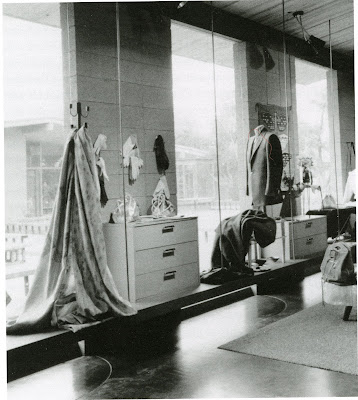Cherokee designer Lloyd Kiva New (1916-2002) played an important role in revolutionizing Native customary clothing design in the mid-1900s. He worked in textile arts, leatherwork, and fashion design with his own boutique (opened in Dec 1945) and center (opened in 1955), and he was active in the development of Scottsdale as an arts center. New's handbags and garments were collaborations with other notable Native artists. For example, for one shirt (pictured below), the horse design was painted by Andrew Van Tsinajinnie, then it was silkscreened onto fabric by Manfred Susunkewa. New designed the shirt, and Charles Loloma made the unique silver buttons.
New became the first Native American to show at an international fashion show in 1951 with his participation in the Atlantic City International Fashion Show. In 1952 he showed there again, and was featured in the Los Angeles Times (below). In 1957, Miss Arizona Lynn Freyse wore a Kiva creation at the Miss America Pageant in Atlantic City.
New’s business prospered when opportunities for Native people were limited and bounded. Upper-class Anglo women wore his garments made with Native American designs in a time when Native cultures were being smothered out and dissolved into American cities through relocation and termination government policies. He expressed his ideas as to the importance of Native cultures (especially the importance of Native contributions to American society and identity) while emceeing fashion shows by resort pools, being interviewed for national articles, hosting art or cultural events, or consulting on Indian art educational programs.
Throughout his career as a fashion and accessories designer, New incorporated Native design concepts, including symbols, materials, silhouettes, cuts, and color palettes, from various tribes, sometimes combining them, to create items that would work within Anglo American paradigms of gender, class, and ethnicity. New acknowledged social limitations and cultural expectations and worked within these frameworks to create new possibilities for Native people.
New went on to co-found the Institute of American Indian Arts in Santa Fe in 1962.
(Note: This is an excerpt from my dissertation and is copyrighted material)
 (Lloyd Kiva New, silkscreening. Image from IAIA Archives.)
(Lloyd Kiva New, silkscreening. Image from IAIA Archives.) (Lloyd Kiva New boutique in Scottsdale, ca. 1950s. Image from Heard Museum exhibit Mid-century Modern: Native American Art in Scottsdale.)
(Lloyd Kiva New featured in the Los Angeles Times, 1952.)
 (Lloyd Kiva New blue sleeveless shirt, ca. 1950s. Private collection. Image my own.)
(Lloyd Kiva New blue sleeveless shirt, ca. 1950s. Private collection. Image my own.) (Lloyd Kiva New sleeveless mini-dress with blue water design, ca. 1950s. Private collection. Image my own.)
(Lloyd Kiva New sleeveless mini-dress with blue water design, ca. 1950s. Private collection. Image my own.) ("It's a Kiva bag". Private collection. Image my own.)
("It's a Kiva bag". Private collection. Image my own.)  (Lloyd Kiva New shirt with desert-inspired colors, ca. 1950s. Private collection. Image my own.)
(Lloyd Kiva New shirt with desert-inspired colors, ca. 1950s. Private collection. Image my own.) (Lloyd Kiva New purse with Charles Loloma silver detailing, ca. 1950s. Image from online auction site.)
(Lloyd Kiva New purse with Charles Loloma silver detailing, ca. 1950s. Image from online auction site.)Read more about New at Native Peoples, or at The New York Times.



